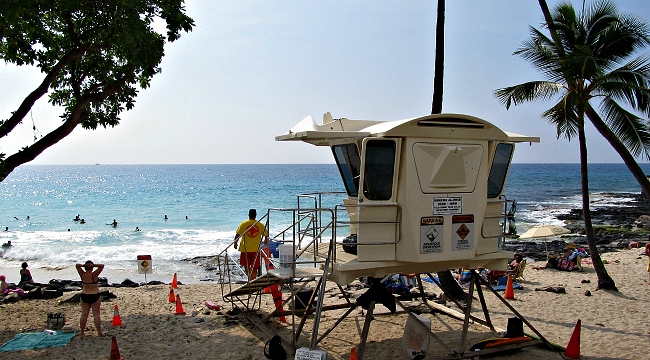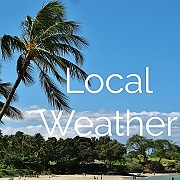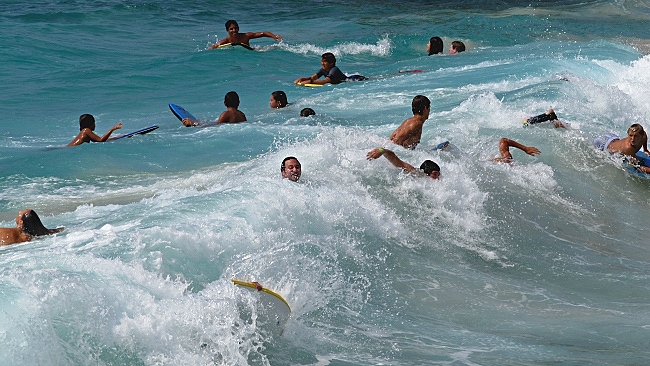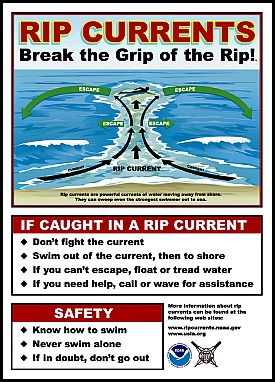Beach Safety on Hawaii Beaches
Considering beach safety before dashing across the hot sand and plunging into the surf may just save a life. Hawai'i may be the drowning capital of the U.S., but by following a few safety guidelines, you won't become another statistic.
Consider that Hawaii is in the middle of the largest ocean on earth. Shoreline surf and currents on many Hawaii beaches can be frighteningly powerful, even when the ocean appears calm. On a calm day along the west coast of the Big Island, the water can be glassy smooth. But things can change in a hurry. Don't underestimate the power of the ocean. Know before you go. If in doubt, enjoy the view from the shore.

General Hawaii Beach Safety Tips:
- Know how to swim. The Pacific Ocean is not your backyard pool.
- Never swim alone.
- Where possible swim at Big Island beaches with lifeguards.
- Ask lifeguards for safety and swimming tips.
- If you don't see others swimming, find out why.
- Read and heed the posted warning signs.
- Before going in the ocean, observe the surf and keep a close eye on changing conditions.
- Always be on the lookout for large waves. They arrive in groups, even when the surf seems calm.
- Use caution walking on wet areas. Wet lava rocks can get very slippery.
- Know your limits. Return to shore before you get tired.
- Remain calm. Panic is your enemy.
- Know the tides. Is the tide coming in or going out?
- Understand rip currents (see below)
More Sun in Hawaii:
Because Hawaii is close to the equator, the sun is intense. This is true at the beach and even more so high up on one of the volcanoes. For maximum protection, apply adequate sun protection 30 minutes before going outside and 30 minutes before swimming. Reapply after swimming. If you are hiking be sure to have plenty of water and take breaks to avoid overexertion and dehydration.
Ocean Waves:
Waves arrive in groups, separated by lulls. Observe the ocean for several minutes before going in the water. Observe other people - are they swimming, or are they on surfboards?
Waves can make dangerous currents. Watch out for waves rushing up a beach or on rocky shores that can knock you down. Unwary visitors have been swept into the ocean when venturing too far out on the rocks.
Rip Currents:
Rip currents are powerful, narrow channels of fast-moving water flowing away from shore. They can move at speeds up to eight feet per second, beginning at the shoreline and flowing swiftly out past the breaking waves. They are more likely to be dangerous when the surf is high, and can be very narrow or hundreds of yards wide.
How do rip currents form?
Under normal conditions, water rolls rhythmically toward shore, forms waves, then breaks in the shallower water. Rip currents are formed as waves break over low spots on reefs or sand bars. As the waves break over these low spots, the water is funneled towards the shore. As the water builds up near shore the pressure creates a concentrated river of water that must move away from the beach to deeper water. The water forced away from shore is known as a rip current. Their strength and speed increases as wave size and speed increases.
How to identify a rip current:
Rip currents are not always easy to identify. Some key things to look for are:
- a channel of churning water that looks like a river
- a line of foam or debris moving steadily out to sea
- a break in the incoming wave pattern with a deeper channel having no waves
What to do if caught in a rip current:
- Stay calm to conserve energy.
- Float in the current. Don't fight it and don't try to swim toward shore.
- Wave for help.
- In a weaker rip current, try to break free by swimming parallel to the shore.
- You will eventually be released from the current as it reaches deeper water.
For further information visit the NOAA website on rip currents and other beach safety.
Have fun and be safe!
Tell your friends about Hawaii beach safety. Share this page on Facebook or Google Plus!
What's your favorite Big Island beach? We're always curious what our readers have to say.
Share your own story, maybe even a photo or two. We'll publish it right here for other readers to enjoy.
Like This Page?
Return from Hawaii Beach Safety to Big Island Beaches
Return from Hawaii Beach Safety to Explore The Big Island Home Page








